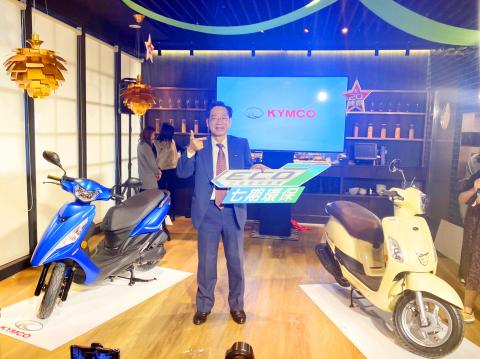Kwang Yang Motor Co (光陽工業), the nation’s largest manufacturer of gasoline-powered scooters, plans to defend its market position next year by rolling out 15 new gasoline-powered scooter models that meet the government’s Phase 7 emissions standards.
To cope with stringent emissions requirements, the company yesterday launched two scooters that it says produce 96 percent less greenhouse gas emissions than scooters that meet the Phase 6 emissions standards.
The older-generation scooters would be phased out, the company said.

Photo: CNA
The Kaohsiung-based company said that local scooter makers are gearing up to launch new low-emission models after the Environmental Protection Administration (EPA) in October introduced the new scooter emissions law to reduce air pollution, which is to go into effect next year, one year earlier than originally scheduled.
The EPA plans to subsidize purchases of fuel-powered scooters that meet the new emissions standards for two years, beginning next year.
People would receive NT$5,000 each for retiring their heavy scooters, or NT$3,000 for light models.
“We will roll out 15 new models gradually that meet Phase 7 emissions standards next year,” Kwang Yang chief executive officer Ko Chun-ping (柯俊斌) told reporters at a year-end media gathering in Taipei.
Sanyang Motor Co (三陽), the No. 3 scooter maker in Taiwan, also plans to launch seven new scooters that meet the Phase 7 standards.
Three of them are to hit the market next month, the company said in a statement yesterday.
Regarding the outlook for the local scooter market next year, Ko maintained a conservative attitude.
“The scooter market will see a volatile year in 2020, as the government’s policies will greatly affect consumers’ behavior,” he said.
Ko said he expects the nation’s scooter sales to shrink 1.16 percent to 855,000 units next year from an estimate of 865,000 units for this year.
Electric scooters are expected to comprise 13.5 percent of the nation’s overall scooter market next year compared with 17.5 percent this year, as a result of government subsidy cuts, he said.
Since early this year, Ko has been calling on the government to scrap the commodity tax on gasoline-powered scooters so that companies can fairly compete with electric scooter manufacturers, rather than just lowering the tax by NT$4,000 per vehicle to replace an old one.
The government levies a 17 percent commodity tax on the retail price of gasoline-powered scooters, but not on electric scooters.
Kwang Yang plans to launch three or four electric scooters next year, Ko said.
The company operates 550 recharge stations where riders can recharge their electric scooters or swap empty batteries for fully charged ones, he said.
Kwang Yang sold 266,394 own-brand scooters, including 8,506 electric models, in the first 11 months of this year, seizing a 33.5 percent share of the market, Ko said.

Taiwan’s long-term economic competitiveness will hinge not only on national champions like Taiwan Semiconductor Manufacturing Co. (TSMC, 台積電) but also on the widespread adoption of artificial intelligence (AI) and other emerging technologies, a US-based scholar has said. At a lecture in Taipei on Tuesday, Jeffrey Ding, assistant professor of political science at the George Washington University and author of "Technology and the Rise of Great Powers," argued that historical experience shows that general-purpose technologies (GPTs) — such as electricity, computers and now AI — shape long-term economic advantages through their diffusion across the broader economy. "What really matters is not who pioneers

In a high-security Shenzhen laboratory, Chinese scientists have built what Washington has spent years trying to prevent: a prototype of a machine capable of producing the cutting-edge semiconductor chips that power artificial intelligence (AI), smartphones and weapons central to Western military dominance, Reuters has learned. Completed early this year and undergoing testing, the prototype fills nearly an entire factory floor. It was built by a team of former engineers from Dutch semiconductor giant ASML who reverse-engineered the company’s extreme ultraviolet lithography (EUV) machines, according to two people with knowledge of the project. EUV machines sit at the heart of a technological Cold

Taiwan Semiconductor Manufacturing Co (TSMC, 台積電) last week recorded an increase in the number of shareholders to the highest in almost eight months, despite its share price falling 3.38 percent from the previous week, Taiwan Stock Exchange data released on Saturday showed. As of Friday, TSMC had 1.88 million shareholders, the most since the week of April 25 and an increase of 31,870 from the previous week, the data showed. The number of shareholders jumped despite a drop of NT$50 (US$1.59), or 3.38 percent, in TSMC’s share price from a week earlier to NT$1,430, as investors took profits from their earlier gains

TAIWAN VALUE CHAIN: Foxtron is to fully own Luxgen following the transaction and it plans to launch a new electric model, the Foxtron Bria, in Taiwan next year Yulon Motor Co (裕隆汽車) yesterday said that its board of directors approved the disposal of its electric vehicle (EV) unit, Luxgen Motor Co (納智捷汽車), to Foxtron Vehicle Technologies Co (鴻華先進) for NT$787.6 million (US$24.98 million). Foxtron, a half-half joint venture between Yulon affiliate Hua-Chuang Automobile Information Technical Center Co (華創車電) and Hon Hai Precision Industry Co (鴻海精密), expects to wrap up the deal in the first quarter of next year. Foxtron would fully own Luxgen following the transaction, including five car distributing companies, outlets and all employees. The deal is subject to the approval of the Fair Trade Commission, Foxtron said. “Foxtron will be